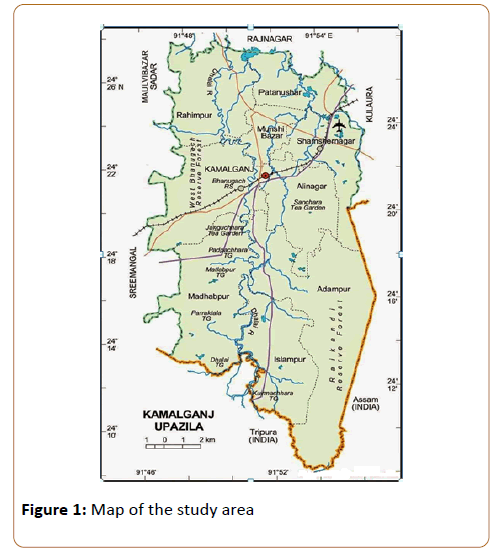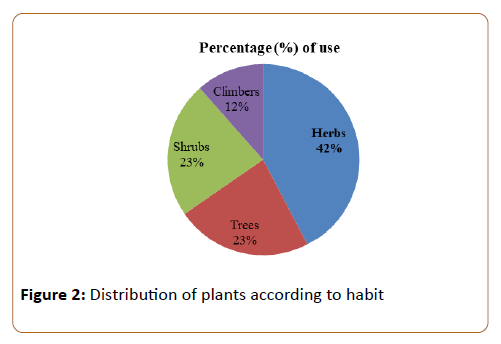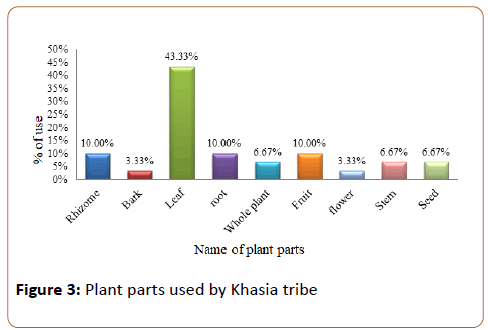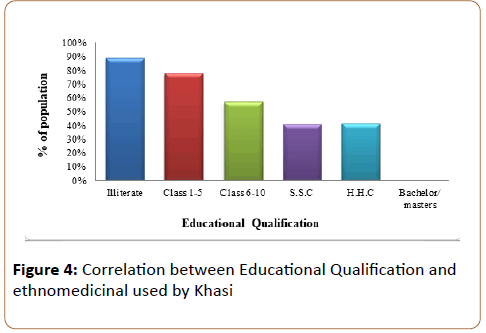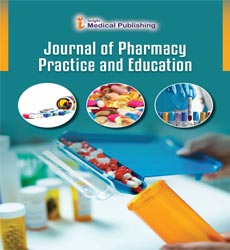Ethnomedicinal Survey of Plants among Khasia Tribes Residing in Kamalganj, Maulvibazar, Bangladesh
Rita Bhatta* and Shuvon Datta
Department of Pharmacy, Noakhali Science and Technology University, Sonapur, Noakhali-3814, Bangladesh.
- *Corresponding Author:
- Rita Bhatta
Assistant Professor, Department of Pharmacy
Noakhali Science and Technology University
Sonapur, Noakhali-3814, Bangladesh
Tel: +8801717383376
E-mail: phar_rita@yahoo.com
Received date: February 25, 2018; Accepted date: March 09, 2018; Published date: March 12, 2018
Citation: R Bhatta, S Datta (2018) Ethnomedicinal Survey of Plants among Khasia Tribes Residing in Kamalganj, Maulvibazar, Bangladesh. J Pharma Pract Edu Vol 1:9.
Copyright: © 2018 Bhatta R, et al. This is an open-access article distributed under the terms of the Creative Commons Attribution License, which permits unrestricted use, distribution, and reproduction in any medium, provided the original author and source are credited.
Abstract
Background: The khasia form the largest tribal communities in the different districts of Sylhet division. Although in recent years the tribal people are more and more resorting to allopathic medicine, the tribes have a long history of medicinal plant use and has its own medicinal practitioners. Thus the aim of the present study was to conduct an ethnomedicinal survey among the Khasia tribal communities residing in Kamalganj Upazila of Moulvibazar district.
Methods: Interviews were conducted with the help of a pre-designed questionnaire and using the guided field-walk method. Total 180 people were interviewed including two traditional health practitioners. Plant specimens as pointed out by the practitioners were collected.
Results: A total of 26 plants from 17 families were documented during our survey. Our study found that, in present conditions about 69% Khasia peoples used ethnomedicinal treatment. Herbs is dominant in use (42%) in this ethnic group. Leaves were the most used plants parts. About 43.33% of the used plant parts were leaves and about 68% of preparations administered orally. Gastrointestinal disorders and respiratory complaints represented the major ailment category with the use of 18% plants species for each in Khasia tribal people. This study also showed that with increasing of the educational qualifications the percentage of Ethnomedicinal practice decreased gradually.
Conclusions: The present work in Khasia community provides the ethnomedicinal use of various medicinal plants for the treatment of various diseases. This kind of study to search a new species for the ailments of many difficult diseases which will enrich present technologically improved store of medicines.
Keywords
Ethnomedicine; Herbal medicine; Ethnic groups; Khasia
Introduction
Since from inception of civilization human was thoroughly dependent on nature, not only for food but also for the treatment of various diseases. Different study reported that around 5,000 years ago human beings were aware of the medicinal properties of plant [1]. Thus the concept ethnomedicine have derived. It is the knowledge of certain herbs, animals and minerals that have curative and palliative effects were transmitted from one generation to another. According to WHO, about three-quarters of the world population relies upon traditional remedies (mainly herbs) for the health care of its people [2]. Most of the important allopathic drugs like aspirin, atropine, ephedrine, digoxin, morphine, quinine, reserpine, artemisinin and tubocurarine have been discovered through close observations of traditional medicinal practices of indigenous peoples [3]. Thus there have enormous potential towards discovery of novel drugs for treatment of a number of ailments, which cannot be treated with current medicines through adequate documentation of the medicinal practices of tribal.
According to Latest ethnographic research the number of tribes within Bangladesh is approximatey 150 [4]. Khasia is one of the ethnic groups of Bangladesh and their population is approximately 12,280 [5]. Earlier, Khasia people used to live along the northeast border of Sunamganj district. At present they are spread over Bishwamvarpur, Tahirpur and Chhatak in Sunamganj and some parts of sylhet and moulvibazar district. There are 85 Khasi punjis across Sylhet Division. There is one Government funded primary school for every four Khasi villages, which is a very low number of schools compared to the Khasi’s population and village size [6]. These people have their own language which was invented by American missionary in the 19th century, but now they are not using it. In local schools, only Bengali and English are taught [7]. They have their own socio culture but they led a poor life in our country. The Khasi mainly do farming, grow betel leaf and rice, maize, sweet potatoes, and lemon. A few of the Khasi punjis have their own cultivable land, but most of the Khasi villages do not formally own the land for their betel leaf plantation. Here, land means forestland with tilas (small hills), which are suitable for betel leaf production. The Khasia children are also found in working tea-garden [5,7].
Because of decline in population, loss in tribal habitat or because of merging with the mainstream Bengali-speaking population, khasia community are on the verge of disappearance of ethnomedicinal practices. If we are unable to gather adequate documents of such knowledge especially traditional medicinal practices, we will lost potential source of many medicinal plant. Thus the main objectives of this study was to collect information of medicinal plants used by khasia community residing in Kamalganj Upazila of Moulvibazar district with information regarding plant parts used, mode of use in various diseases. A correlation was tried to make between ethnomedicinal practices with educational qualification.
Methods
Study area
The survey was done in the patrakhola khasia punji under Kamalganj Upazila of Maulvibazar district, Bangladesh. It lies between 24°08' and 24°28' north latitudes and between 91°46' and 91°57' east longitudes. The total area consists of 48526 ha, including 8202 ha of forest area. Kamalganj is bounded by Moulvibazar Sadar and Rajnagar upazilas on the north, Tripura (India) on the south, Kulaura and Tripura (India) on the east, Sreemangal and Moulvibazar Sadar on the west (Figure 1). About 23% area of the upazila is hilly. The total arable land is 22672 ha, non-agricultural land 8748 ha, fallow land 506 ha and khash land 787.44 ha. The soil of this upazilla is generally sandyloam soil [8].
Methods
A total of 180 people were interviewed, including community people and their traditional health practitioners [2]. All of the informant’s age range between 20 to 80 years. We followed Martin and Maundu [9,10] methods for collection of data. In this method, the Kavirajes took the interviewers on guided fieldwalks through areas from where they collected their medicinal plants, pointed out the plants, and described their uses. The studies were undertaken during December, 2016-February, 2017.
The ethnomedicinal data was collected through open and focused group discussions, and personal interviews using predesigned questionnaire. A simple bangla questionnaire was developed based on some basic knowledge of the traditional medicinal practitioners (kabiraj) and peoples of tribal communities. Photograph of available plants was taken for identification. The information about the plants was crosschecked among the traditional healers and some other peoples of the communities. The scientific name, family and of the plants was identified from the local name and by matching photographs from internet and many published papers.
Results
In this Ethnomedicinal survey total 26 plants were chosen finally including herb, shrub, tree and climber distributed into 17 families. All the chosen plants were distributed into a table (Table 1) according to their local name.
| SI. No. | Local name | Scientific name | Family/ Habit | Used parts | Diseases, formulation and administration | No of ailment categories |
|---|---|---|---|---|---|---|
| 1 | Ada | Zingiber officinale Roxc. | Zingiberaceae/Herb | Rhizome | Diarrhoea. Juice obtained from Zinger’s rhizome is taken orally to treat Diarrhoea. | 2 |
| Herb | Cough. Juice obtained from Zinger’s rhizome is taken with salt to treat cough. | |||||
| 2 | Akon | Calotropis gigantea | Apocynaceae/Shrub | Leaf | Indigestion. One teaspoonful of dried root powder taken daily. | 2 |
| Root | Joint pain. Warm the whole leaves then bound the leaves on swelling site. | |||||
| 3 | Arjun | Terminalia arjuna | Combretaceae/Tree | Bark | Heart problems. Powder of dried bark mixed with water or milk and taken 2-3 times daily. | 2 |
| Cough. Powder of dried bark mixed with Justicia adhatoda L and take 2-3 times daily. | ||||||
| 4 | Badui lota | Peaderia foetida L | Rubiaceae/Climber | Leaf | Indigestion, Diarrhoea. Pill made by crushing the leaves and taken orally to treat GIT disorder. | 1 |
| 5 | Bashak | Justicia adhatoda L. | Acanthaceae/Shrub | Leaf | Chronic cough. Leaves are boiled with water is given orally to treat chronic cough. | 2 |
| Pain. Warm leaves with old ghee are applied to painful areas for instant relief. | ||||||
| 6 | Dankalos | Ipomoea fistulosa Roxb. | Convolvulaceae/Shrub | Whole plants | Cold, Fever. Whole plants are crushed and juice taken orally to treat common cold diseases. | 2 |
| 7 | Dutura | Datura metal | Solanaceae/Herb | Leaf | Asthma. Dried and powdered leaves of Datura metal are wrapped by a leaf of Justicia adhatoda and take smoke as a Cigarette. | 2 |
| Arthritis. Juice obtained from fresh leaves mixed with mustard oil and applied directly on painful areas. |
Table 1: List Medicinal plants and their formulations used for treatment of various diseases by Khasia tribes
The table also contains their scientific name, family, habit, used plant parts, diseases, formulation and administration and name of user communities. This plants are then analyzed according to their types (Figure 2) and parts of the plant (Figure 3) used by these community. Table 2 displayed the ailments treated by these plants.
| Category | Common diseases | No. of species uses (%) |
|---|---|---|
| Gastrointestinal disorders | Dysentery, diarrhea, indigestion, gastritis | 8 (18) |
| Fever | Fever, rheumatic fever | 3 (7) |
| Respiratory complaints | Cough, chronic cough, asthma, cold | 8 (18) |
| Diabetes | Diabetes | 2 (5) |
| Dermatological problems | Wounds, cuts, skin infection, scabies, bleeding from cuts and wounds, chicken pox, alopecia, hair tonic | 7 (16) |
| Urinary and rectal diseases | Urinary disorder, piles. | 2 (5) |
| Inflammation and pain | Rheumatic pain, bone pain, body pain, leg pain, joint pain, Arthritis, toothache | 6 (14) |
| Sexual stimulant | Impotency, weakness | 1 (2) |
| Hair | Alopecia, hair tonic | 1 (2) |
| General health | Physical weakness | 1 (2) |
| Helminthiasis | Worms infection | 1 (2) |
| Cardiovascular disease | Heart diseases, High blood pressure | 2 (5) |
| Bite and stings | Insect bite | 1 (2) |
| Ophthalmic | Conjunctivitis | 1 (2) |
Table 2: Ailments treated by plant species
Discussions
Among these various families Lamiaceae have the highest number of plants which is three. Apocynaceae, Araceae, Asteraceae, Combretaceae, Meliaceae, Zingiberaceae have two plants each. Other families have one plant each under them.
This study found that 4 types of plants used by the tribal communities (Tree, Shrub, Herb and Climber). Among them herbs are most widely used plants which constituted 42% of plants and trees 23%, shrubs 23% and climbers 12% respectively (Figure 2). A similar trend was also observed by Halim et al. [11] and Ghani [12] who conducted researches on other communities of Bangladesh.
About 69% people of Khasia community uses herbal medicines due to lower availability of allopathic treatment. They are greatly dependent on local medical practitioner called kabiraj to collect these herbal formulation to treat various diseases. These study also found that younger to old member of the family also have knowledge about some uses of plants in some diseases wounds, cut, diarrhea, cold, cough, fever and indigestion. This also coincide with the findings of Rana et al. [8] and Halim et al. [11]. The Khasia people collect these medicinal plant from jungles, village groves and river banks rather than cultivation. The reason behinds this is low financial condition. Although the indigenous practitioners, kabiraj also believe that the medicine collected from the wild source are more beneficial in treating diseases than cultivated one due to the higher accumulation of active constituents. This finding is supported by Anonymous [13] as in Bangladesh more than 90% of medicinal plants come from the wild.
Different types of plants parts such as leaf, stem, root, bark, fruit, flower, seed and gum were used for the treatment of various diseases. about 43.33% of the used plant parts are leaves followed by rhizomes, roots, fruits each contains 10.00%, whole plants, stem, seed each contains 6.67% and barks, flowers each contains 3.33% (Figure 3) and (Figure 4). Study conducted by Bhowmik et al.[14], Rana et al. [18] and Halim et al. [11] also reported the dominant uses of leaves to ailment of various diseases. It confirms sustainable harvesting of medicinal plants. It adds an incentive to protect and maintain wild populations and their habitats and the genetic diversity of medicinal plants [15].
A total of 26 plant species were identified by the Kavirajes and indigenous people along with their medicinal uses to treat 39 ailments in khasia tribal community. Majority of plant species in the study area is found for the ailment of gastrointestinal disorders (18%) and respiratory complaints (18%) (Table 2). Six plant species was reported in this study to recover cough. These species are Justicia adhatoda, Zingiber officinale, Terminalia arjuna, Mentha piperata, Areca catechu and Ocimum tenuiflorum. To treat chronic cough Justicia adhatoda leaves boiled with water is taken orally by the khasia tribal community. The use of Calotropis gigantean, Peaderia foetida, Piper betel and Mentha piperata for treatment of indigestion was found in the study area. Mentha piperata is used to treat both cough and indigestion. Whole plants juice of Ipomoea fistulosa and leaves juice from Ocimum tenuiflorum is reported to cure cold among the khasia people. Combination of Datura metal and Justicia adhatoda against asthma were recorded in the study area. The same use of Datura metal was also found in southern district, Noakhali of Bangladesh [14].
Diabetes was found to be treated by the Khasia people using Swietenia mahagoni and Catharanthus roseus. Most of the Khasia tribal people frequently treat high blood pressure using Catharanthus roseus and bark of Terminalia arjuna in heart problems. Rana [8] reported the use of T. arjuna as heart tonic by the Manipuri communities of Bangladesh. A few remedies were applied externally (Tagetes erecta, Mikania cordata, Ageratum conyzoids, Ocimum tenuiflorum, Citrus medica, Azadirachta indica, Piper betle) for curing ailments such as wounds, cuts, scabies, alopecia, hair tonic, pox and conjunctivitis. Mimosa pudica extract mixed with sugar is used to treat piles in khasia community people. This findings is in accordance with the findings of Rana MP, et al. [8].
Relation between educational qualification and ethnomedicinal use
In this study a relation was tried to make between ethnomedicinal practice among khasi’s population and their educational qualification as intermigration within Bangladesh has occurred among the educated Khasis and is increasing day by day. Some Khasi have started to move to cities for higher education. In Bangladesh, 81.63 percent of the Khasi follow Christianity (which has brought new information and thoughts with regards to social activities), 11.8 percent follow traditional beliefs, and around 3.6 percent of the Khasis follow Hinduism [16]. The study revealed that with the increase of education level the percentage of people who used ethnomedicinal treatment decreased gradually. It was found that in Khasia tribe 89.29% illiterate people used ethnomedicinal treatment.
Conclusions
This survey based study provides the ethnomedicinal use of 26 medicinal plant species for the treatment of both acute and chronic ailments by Khasia tribal communities in Maulvibazar district. Most of the ethnomedicinal plants are comes directly or indirectly from the forest and jungle. But due to huge deforestation and unsustainable resource exploitation the natural forest of the region is degraded and shrinking alarmingly. It is necessary to ensuring sustainable harvesting and cultivation of popular ethnomedicinal species in home gardens and other unused or barren lands to prevent destruction of various rare species of plants. It is required to conduct extensive research on these reported plants for more rational uses. Through this proper scientific analysis, novel compounds can be isolated to treat both old and emerging diseases as this study reported a rich diversity of medicinal plants used to cure various disease. This kind of study should be extended to other parts of the country to discover any unknown potential use of any medicinal plants that have not been mentioned before, but is being used for the centuries to treat many difficult diseases.
References
- Sofowora A (1996) Medicinal plants and traditional Medicine in Africa. J Altern Complement Med 2: 365-372
- Gilani AH, Molla N, Rahman AU, Shah BH (1992) Role of natural products in modern medicine. J Pharm Med 2: 111-118.
- Gilani AH, Rahman AU (2005) Trends in ethnopharmacology. J Ethnopharmacol 100: 43-49.
- Murmu M (2009) Adivasi Anneshon. Nawroze Kitabistan, Dhaka-1100, Bangladesh.
- Singha R (2014) Kinship and Marriage System among the Khasis of Bangladesh: A Study of Khasi Culture and Identity. Bangladesh Development Research Working Paper Series (BDRWPS).
- Potam R (2010) Khasi. In: Mangal Kumar Chakma, J. K. Pallab Chakma, M. Marma and Helena Talang (eds.) Bangladesh Adivashi (Dhaka: Utsho Prokashon).
- Shikdar MK, Biswas A, Mollick R (2013) The Socio-Economic Background of Khasia Ethnic Community of Bangladesh. IOSR J Humanit And Soc Sci (IOSR-JHSS) 7: 58-72.
- Rana MP, Sohel MSI, Akhter S, Islam MJ (2010) Ethno-medicinal plants use by the Manipuri tribal community in Bangladesh. J For Res 21: 85-92.
- Martin GJ (1995) ‘People and Plants’ Conservation Manual, Chapman and Hall, London. Ethnobotany pp. 268.
- Maundu P (1995) Methodology for collecting and sharing indigenous knowledge: a case study. Indigenous Knowledge and Development Monitor 3: 3-5.
- Halim MA, Chowdhury MSH, Wadud AI, Uddin MS, Sarker SK, et al. (2007) The use of plants in traditional health care practice of the Shaiji community in South-Western Bangladesh. J Trop For Sci 19: 168-175.
- Ghani A (2003) Medicinal Plants of Bangladesh with Chemical Constituents and Uses. Second edition. Asiatic Society of Bangladesh, Ramna.
- Trade in Medicinal Plants (2005) Rome, Italy: Economic and Food Agricultural Organization of the United Nations.
- Bhowmik R, Saha MR, Rahman MA, Islam MAU (2014) Ethnomedicinal Survey of Plants in the Southern District Noakhali, Bangladesh. Bangldesh J Pharmacol 17: 205-214.
- Schippmann U, Leaman DJ, Cunningham AB (2002) Impact of cultivation and gathering of medicinal plants on biodiversity: global trends and issues. In: Biodiversity and ecosystem approach in agriculture, forestry and fisheries. Satellite event on the occasion of the ninth regular session of the commission on genetic resources for food and agriculture. Rome, Italy.
- Costa, Thomas, Dutta A (2007) (edited by Philip Gain and Aneeka Malik). The Khasis of Bangladesh: A Socio-economic Survey of the Khasi People (Dhaka, Bangladesh: Society for Environment and Human Development (SEHD).
Open Access Journals
- Aquaculture & Veterinary Science
- Chemistry & Chemical Sciences
- Clinical Sciences
- Engineering
- General Science
- Genetics & Molecular Biology
- Health Care & Nursing
- Immunology & Microbiology
- Materials Science
- Mathematics & Physics
- Medical Sciences
- Neurology & Psychiatry
- Oncology & Cancer Science
- Pharmaceutical Sciences
